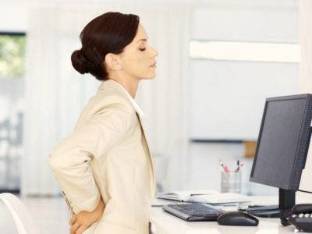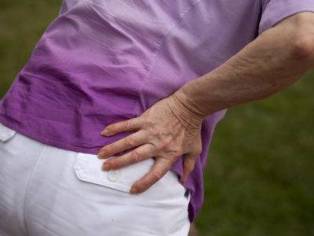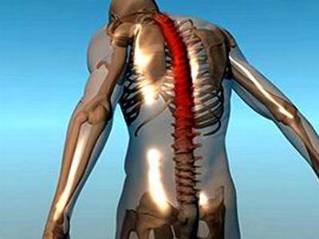If a Person is in pain, any back in the lumbar area, the reasons can be different by the time the kidney disease. Most often this Symptom is due to disease of the lumbosacral spine. Cross part that is movable, what is the reason for more frequent violations of exactly this area.
Why develops the pain syndrome?

The back is only a Symptom pain. Acute pain in the lower back in connection with the breach of the lumbar vertebrae and the CDs, it is called lumbago. Why hurts the back in the lower part, everyone should know. There are the following causes for this Symptom:
- Osteochondrosis in lumbosacral area of the spine;
- the fracture between the vertebral body;
- Ankylosing Spondylitis;
- the displacement of the vertebrae;
- congenital malformations (availability, incremental lumbar, split-up sheets);
- congenital forms of injury of the spine;
- neoplasms benign, malignant and vascular tumors;
- Rheumatism;
- Inflammation of the back muscles (Myositis);
- Sciatica;
- Fracture of the spine;
- Spondylolisthesis;
- Osteomyelitis;
- fibrositis;
- Osteoporosis;
- Disc protrusion;
- Narrowing of the spinal canal;
- Osteoarthritis;
- Diseases of the kidney (hydronephrosis, Pyelonephritis, Tumor).
The spine in the area of the loin may be ill cramps due to the simple muscle. It is possible, during hard cornering or performing athletic exercises. Back pain in the lumbar region is more common in people who have a sedentary way of life and the force of gravity. In the case of persons who are involved in sports, this pathology is much less frequently.
Sciatica, Osteochondrosis
If ever the back hurts from the rear, so this may be a Manifestation of osteochondrosis of the lumbar-sacral spine. It is a disease that primarily affects the intervertebral discs between the vertebrae. They are thin, leading to friction between them and the reduction in the mobility of the disc. Arrange the following predisposing factors for developing this disease:
- hours remain long in an uncomfortable Position;
- the long slope of the upper part of the body;
- insufficient warm-up at the Sport;
- Weakness of the muscles and ligaments of the back;
- the wearing of backpacks on 1 belt;
- the availability of flatfoot;
- heavy physical work;
- large static load;
- the wrong organization of the workplace.
Back the most important signs of osteochondrosis are pain. In the case of 1 degree of the disease, pain syndrome are missing. In the development of the bulging Disc, lumbago developed. It is a sudden pain appeared back. Some people feel that you like an electric shock. It is the sudden change in the posture or the motion will appear.
If back pain in the lumbar area, can be the cause of low back pain. This is a chronic pain in osteochondrosis. Their appearance does not depend on the motor activity of the people. The pain is aching. To turn such people hard to the body. In the Position of the Person lying on the back, the pain syndrome disappears or decreases.
In the case of osteochondrosis grade 3 radicular syndrome developed. He manifested lumborum ischialgia. It is a pain in the lower extremities to the toes. Often it is combined with the violation of the sensitivity. Complaints in the area of the lumbar spine due to the feeling of pressure to nerves, blood vessels and muscle spasm.
Signs of inguinal hernia

If on back pain, the reasons are may incidents in the intervertebral disc. This is a very common disease. If you moved the core of the disc vertebra. Often, against this background, the rupture of the annulus fibrosus. Incidence of 150 cases per 100 thousand people. Arrange the following possible causes for the formation of hernias:
- Injuries (Bruises, Falls);
- Osteochondrosis of the lumbar-sacral spine;
- overweight;
- crooked spine;
- sharp curves.
At risk are the driver and the employees who work at the Computer. Pain in disc herniations has the following features:
- locally;
- often in the thighs, buttocks and lower legs;
- combined with other symptoms (numbness, tingling);
- is amplified during physical exertion.
Severity of pain is determined by the size of the hernia. If you are tall, then sciatica can develop. He manifested sciatica. It is a strong pain in the Form of lumbagoes.
Hernias are the most patients the pain develops according to the kind of lumbago. Among the additional symptoms, the reduction of the hernia potency, limited mobility of the lumbar spine, weakness in the legs. Sometimes disturbed water.
Symptoms of ankylosing Spondylitis
In the case of back pain in the sacral region and in the waist for a longer period of time, the suspicion of ankylosing spondylitis.
This chronic, systemic disease, the most commonly affected joints of the spine. The exact causes for the development of this disease is not installed. There are the following possible etiological factors:
- Inflammation of the genitourinary system;
- Under cooling;
- Injuries to the bones;
- hereditary predisposition;
- the infection.
Ankylosing spondylitis occurs mainly in young people between the ages of 15 to 40 years. This pathology is shown and not the symptoms. Back pain and stiffness of the spine as the early symptom. The pain in the lumbosacral. In the early stages, she is weak. Its appearance is due to inflammation.
The pain is on both sides. Many people indicate that the pain syndrome is most clearly pronounced with one Hand. It takes more than 3 months and does not go away. The disease develops very slowly. Pain interferes with such people, mainly in the morning hours. Perhaps their appearance, after a prolonged static load.
The middle of the day, it is reduced. Pain increases in rest and disappears during the operation. In the stage of the amount of the pain occurs at night and during the work. In the later stages of a sciatica develops. Pain in ankylosing spondylitis combined with the deterioration of the General condition of man, fear in the chest, shortness of breath, loss of head, pain in the muscles and in the chest. Often affects the eyes.
Diseases of the kidneys

If back pain in the lower back, can be the cause of the disease of the kidneys (hydronephrosis or Pyelonephritis). The kidneys are located retroperitoneal. In the case of inflammation (Pyelonephritis) in the lower back the most common complaint of patients is pain. This disease often shows itself in children and young girls. Pyelonephritis often develops on the background of Nephrolithiasis.
Infectious nature of the disease. Most evident is the acute Pyelonephritis. It is characterized by pain in the lower back, nausea, fever, chills, weakness, malaise, frequent urination. Often there is edema. Pain is usually one-sided, stupid and constant. Irradiation it is possible, in the area of the upper abdomen, lower abdomen and navel.
If the back pain, the causes nephrosis in the hydro. It is a disease in which the renal calices and renal pelvis. Often, this pathology develops in young children. The basis for the development of hydronephrosis is a violation of the outflow of urine, a faulty operation of the valves and blockage of the urinary tract.
In hydronephrosis, there is a sharp pain in the back. It is irradiating. It occurs in the page, a little above the pelvis. Pain paroxysmal, reminiscent of renal colic. Pain syndrome combined with nausea, vomiting, the appearance of blood in the urine.
Symptoms of sciatica
If strong is the spine in the area of the loin that hurts the cause may be an inflammation of the sciatic nerve. This condition is called sciatica. At risk are older people. Sciatica (sciatica) often develops on the background of a herniated disc, infectious diseases (influenza, Malaria, tuberculosis), arthritis, poisoning. Often sciatica in pregnant women is observed.
Pain when sciatica has the following features:
- acute (like a knife);
- drilling;
- Intensive;
- burning or stinging;
- first of all, appears in the lower back, and then rises (the event character);
- apply to buttocks, thighs, and lower legs;
- constantly interferes in the Form of attacks;
- has a different effect;
- often one-sided.
Pain accompanied by tingling, numbness, and movement disorders. Among the other symptoms of sciatica, muscle atrophy, disruption of the sweat, dryness, and thinning of the skin.
The Plan of examination of patients
Not everyone knows what to do if your back hurts in the lumbar area. You should consult a doctor and check. You will need the following investigations:
- Computed tomography;
- Radiography of the lumbosacral spine;
- Uzi the kidneys;
- Magnetic Resonance Imaging;
- electroneuromyography;
- Doppler sonography of the vessels;
- General and biochemical analysis of the blood;
- the analysis of the urine;
- cystourethrography.
Necessarily the inspection and Palpation of the lumbar area and spine. Required the consultation of the nervous doctor or vertebrologist. On examination, the doctor evaluates the mobility of the spine, reflexes, muscle strength, agility in the limbs. Almost always the cause of back pain diseases of the spine. They are easy to identify on an image.
Therapeutic Measures

If strong of back pain, then the treatment should be aimed at the underlying cause of the pain. The following treatment methods shall apply:
- systemic drug therapy;
- the use of local analgesics in the Form of gels and ointments;
- Physiotherapy;
- manual therapy;
- Acupuncture;
- Blockade;
- surgical treatment;
- Movement therapy.
Such patients exercise and Protein should comply with the diet. All exercises must have a high Amplitude. If back pain is a Symptom of Pyelonephritis, requires bed rest, pain relievers and antibiotics. In the case of chronic inflammation, in addition, urinary ordered driving. Of antibiotics, fluoroquinolones, penicillins, preferably and.
In addition, modulators and vitamins ordered immune. In the case of the development of hydronephrosis, surgical treatment may require. The pain on the background of the sciatica analgesics (AnalGin), shower agents, NSAIDs apply. In severe cases, required novocaine Blockade. In the scheme of treatment of massage, exercises, acupuncture.
For the elimination of pain is performed can be therapy draws. Apply the ointment with bees wax or a poisonous snake. For herniated NSAIDs stretching the spine, Massage and physiotherapy. In severe cases, surgery is necessary. In pain against the background of sciatica treatment is the immobilization of the spine, the application includes the intramuscular administration of analgesic and anesthetics. In addition, the vitamins of the group B (Kombilipen).
Effectively and physiotherapy. In the case of the detection of osteochondrosis kinesitherapy, Massage, pain medication, exercise therapy shows. Necessarily chondroprotectors appointed. These patients need to move more and to spend less time standing or sitting. In the scheme of treatment of manual therapy and Blockade. So, the emergence of pain in the lower back is the reason for the treatment in the hospital.



























